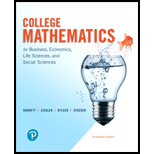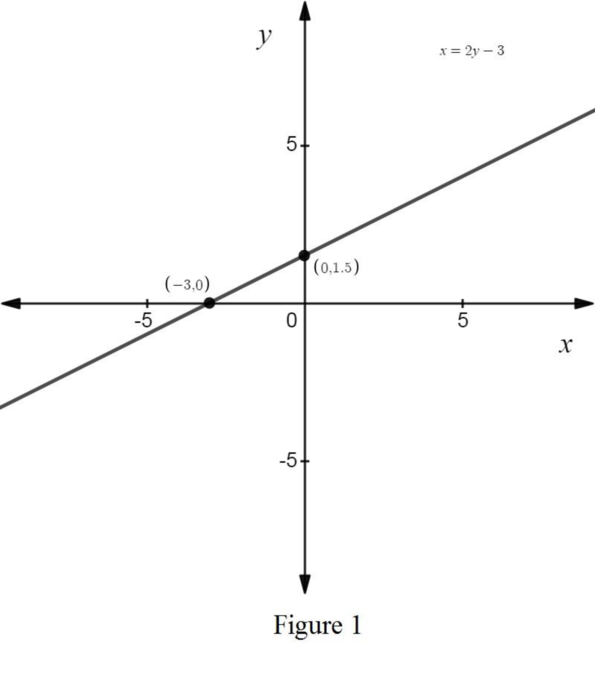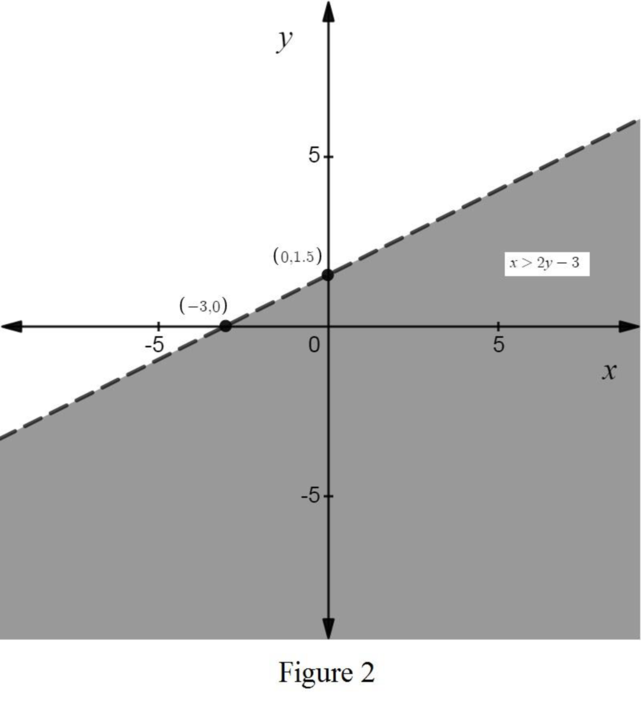
To graph: The given inequality
Explanation of Solution
Given:
The inequality is
Procedure used:
To graph the linear inequality use the following steps.
Step1: First graph
Step2: Choose a test point anywhere in the plane not on the line [the origin
Step3: Does the test point satisfy the original inequality. If so, shade the half plane that contain the test point. if not, shade the opposite half plane.
Graph:
Steps involved to graph of inequality
Step1: First draw the graph of the equation

Step 2: Choose the test point above or below the line. Let’s take
The statement is true. So
Step 3: Hence the graph of the solution set of the inequality

It is observed that the solution set contain origin and the solution set is the shaded region excluding boundary line.
Want to see more full solutions like this?
Chapter 5 Solutions
College Mathematics for Business, Economics, Life Sciences, and Social Sciences + Mylab Math With Pearson Etext Title-specific Access Card:
- Answer questions 8.2.6, 8.2.7 and 8.2.9 respectivelyarrow_forwardTo the Internal Revenue Service, the reasonableness of total itemized deductions depends on the taxpayer’s adjusted gross income. Large deductions, which include charity and medical deductions, are more reasonable for taxpayers with large adjusted gross incomes. If a taxpayer claims larger than average itemized deductions for a given level of income, the chances of an IRS audit are increased. Data (in thousands of dollars) on adjusted gross income and the average or reasonable amount of itemized deductions follow. Adjusted Gross Income ($1000s) Reasonable Amount ofItemized Deductions ($1000s) 22 9.6 27 9.6 32 10.1 48 11.1 65 13.5 85 17.7 120 25.5 Compute b1 and b0 (to 4 decimals).b1 b0 Complete the estimated regression equation (to 2 decimals). = + x Predict a reasonable level of total itemized deductions for a taxpayer with an adjusted gross income of $52.5 thousand (to 2 decimals). thousand dollarsWhat is the value, in dollars, of…arrow_forwardAnswer questions 8.1.10, 8.1.11and 8.1.12 respectivelyarrow_forward
- 7.2.10 Researchers in the Hopkins Forest also count the number of maple trees (genus acer) in plots throughout the forest. The following is a histogram of the number of live maples in 1002 plots sampled over the past 20 years. The average number of maples per plot was 19.86 trees with a standard deviation of 23.65 trees. a. If we took the mean of a sample of eight plots, what would be the standard error of the mean? b. Using the central limit theorem, what is the probability that the mean of the eight would be within 1 standard error of the mean? c. Why might you think that the probability that you calculated in (b) might not be very accurate? 2. A normal population has mean 100 and variance 25. How large must the random sample be if you want the standard error of the sample average to be 1.5?arrow_forwardAnswer questions 7.3.10 and 7.3.12 respectively 7.3.12. Suppose that two independent random samples (of size n1 and n2) from two normal distributions are available. Explain how you would estimate the standard error of the difference in sample means X1 − X2 with the bootstrap method.arrow_forwardAnswer questions 7.4.6 and 7.4.7 respectivelyarrow_forward
- Write an equation for the function shown. You may assume all intercepts and asymptotes are on integers. The blue dashed lines are the asymptotes. 10 9- 8- 7 6 5 4- 3- 2 4 5 15-14-13-12-11-10 -9 -8 -7 -6 -5 -4 -3 -2 1 1 2 3 -1 -2 -3 -4 1 -5 -6- -7 -8- -9 -10+ 60 7 8 9 10 11 12 13 14 15arrow_forwardK The mean height of women in a country (ages 20-29) is 63.7 inches. A random sample of 65 women in this age group is selected. What is the probability that the mean height for the sample is greater than 64 inches? Assume σ = 2.68. The probability that the mean height for the sample is greater than 64 inches is (Round to four decimal places as needed.)arrow_forwardAnswer questions 8.1.4, 8.1.5 and 8.1.6 respectivelyarrow_forward
 Discrete Mathematics and Its Applications ( 8th I...MathISBN:9781259676512Author:Kenneth H RosenPublisher:McGraw-Hill Education
Discrete Mathematics and Its Applications ( 8th I...MathISBN:9781259676512Author:Kenneth H RosenPublisher:McGraw-Hill Education Mathematics for Elementary Teachers with Activiti...MathISBN:9780134392790Author:Beckmann, SybillaPublisher:PEARSON
Mathematics for Elementary Teachers with Activiti...MathISBN:9780134392790Author:Beckmann, SybillaPublisher:PEARSON
 Thinking Mathematically (7th Edition)MathISBN:9780134683713Author:Robert F. BlitzerPublisher:PEARSON
Thinking Mathematically (7th Edition)MathISBN:9780134683713Author:Robert F. BlitzerPublisher:PEARSON Discrete Mathematics With ApplicationsMathISBN:9781337694193Author:EPP, Susanna S.Publisher:Cengage Learning,
Discrete Mathematics With ApplicationsMathISBN:9781337694193Author:EPP, Susanna S.Publisher:Cengage Learning, Pathways To Math Literacy (looseleaf)MathISBN:9781259985607Author:David Sobecki Professor, Brian A. MercerPublisher:McGraw-Hill Education
Pathways To Math Literacy (looseleaf)MathISBN:9781259985607Author:David Sobecki Professor, Brian A. MercerPublisher:McGraw-Hill Education





